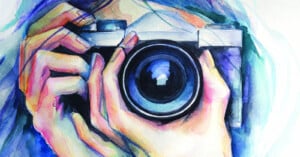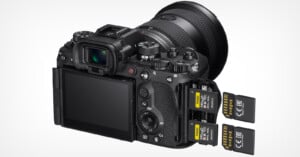
Has Kate Middleton Just Ended All Remaining Trust in Photographs?
Today my mother-in-law texted me to say, "Can't trust any photo." Why? Kate Middleton.

Today my mother-in-law texted me to say, "Can't trust any photo." Why? Kate Middleton.

Sight was the first of our senses to be technologically shared in a world we did not witness with our own eyes. Photography—writing with light—has historically meant a one-to-one relationship between what was before a camera (defined as a lens focussing light on a recording media) and what came out the other end, created by a human.

For decades, professional photographers have been using the pairing of a 70-200mm f/2.8 and a 300mm f/2.8 to achieve their telephoto goals. Canon introduced the RF 100-300mm f/2.8 L IS USM recently and it just about covers the range of both those lenses. But is it as good?

AI image generators are trained on millions -- even billions -- of photos. It is safe to assume the vast majority of these photos are copyrighted and used without permission.

Apple appeared content to sit by the sidelines as the AI craze took the tech world by storm last year, but that has changed. Apple is all in on AI, and it seemingly happened in the blink of an eye.

The 10-year anniversary of Ellen DeGeneres' internet-breaking Oscars selfie reveals just how much photo culture has changed.

This past week, the PetaPixel team came across an opinion on a photography blog that we didn't think was fair. In short, it argued that all "small sensor cameras suck," which is just not true.

It's been a hot minute since I've played with a true superzoom, so I was unusually excited to see how Panasonic's new compact 28-200mm f/4-7.1 -- the L-mount's first all-in-one zoom lens -- performed.

Sitting in a McDonald's restaurant smoking a cigarette while eating a burger, this "peak male specimen" apparently had his picture taken in 1989, according to the caption.

A child's online privacy has long been a concern for parents and guardians, and even law enforcement. It is a topic mired in debate, and it's also an ever-changing technological landscape thanks to new AI tools. Wading into the complicated situation is freelance writer Hannah Nwoko in a new piece for The Guardian.

World-class chipmaker NVIDIA became the first company in its industry to reach a market cap above $2 trillion. This remarkable high water mark capped off an incredible week for NVIDIA, which posted record revenue last week.

In 2016, Adobe developed a technology that was best described as "Photoshop for audio." It would be able to change words in a voiceover simply by typing new words. Sounds scary, right? It was, and Adobe never released it -- for good reason.

During Sunday's Super Bowl commercials, a set of incredible photos were seen by some 123 million people. Regardless of where you stand on the Jesus-themed ad, it was a pretty cool moment for photography.

I can be called an Apple fanboy. I'd push back on the notion that I love everything the company does but for better or worse, I'm ingrained in the Apple ecosystem and have been for more than two decades. So naturally, I've been eagerly awaiting the Apple Vision Pro.

In a recent interview, a Samsung executive attempted to gaslight us all by saying that no photo is really "real."

The OM-1 Mark II has landed with more of a whimper than a bang. It's a great camera but there's not much new about it. However, the rush to pass judgment on what the lack of novel features means for the future of OM System and Micro Four Thirds at large is premature.

The 135mm focal length is one of my favorite portrait ranges due to its compressed rendering of people’s faces, as well as lending itself to stunningly dramatic full-body environmental portraits. Last year saw the release of two new 135mm lenses, one each from Canon and Nikon. Take into account the venerable Sony 135mm G Master and you have all three of the major full-frame mirrorless companies now offering a 135mm f/1.8 lens.

A viral photo of a classic home computer setup from the early 2000s has sparked a wave of nostalgia from millennials.

Following DPReview publising its Sony a9 III studio test shots, PetaPixel wrote about our hands-on experience with the a9 III's image quality. We wanted to add more context to that discussion, even if it spoils parts of our impending review.

As photographers flip their calendars over to 2024, waving goodbye to a year of great gear and hopefully even better photos, it is time for shutterbugs to usher in the New Year with top-notch -- and totally realistic -- New Year's resolutions.

We all have to start somewhere. For most of us, that means a basic DSLR or mirrorless camera kit with a compact, handy general-purpose zoom lens. Undoubtedly, we can't wait to ditch our basic kit lens for something faster or more versatile. A kit lens is something we feel we need to graduate from to call ourselves an accomplished photographer. But is that really the case? Maybe the humble kit lens has more to offer than we think, so today we will look at our five favorite kit lenses of all time.

This year has been a fascinating one in the world of photography, and like every year, it was full of incredible highs, devastating lows, and everything in between.

This past summer, I hit the hot streets of Marrakech, Morocco with Lomography's new LomoChrome '92 film in a Canon AE-1 SLR camera with a 50mm lens.

In a recent opinion piece, The New York Times delcared that AI is the "future of photography." Whether that's true or not remains to be seen but it has undoubtedly been a big year for images generated by artificial intelligence.

Now in its third year, PetaPixel has gathered its team together to guess the things they just know are going to take place over the next calendar year. All of us are, as usual, ready to be very, very wrong.

Kate Middleton and Prince William released their Christmas card photo of them posing with their children over the weekend which caused a stir after many accused them of a "Photoshop fail."

Earlier this week, PetaPixel reported on a remarkable story that scientists AI-generated images from peoples’ brains with “75 percent accuracy.”

Much of the focus on the potential hazards of generative AI technology has understandably been on how it impacts artists and copyright ownership, and how it could affect people's jobs and wages. New research shows that the dangers of generative AI go much further and may be catastrophic for the environment.

The Sony World Photography Awards is arguably the most prestigious and largest photo contest. The 2024 edition is open to entries and some of its rules are under fire.

The Sony a9 III is still months away from release but has already sent photographers into a frenzy. The positive buzz around the camera is as high as any camera reveal ever, and with good reason. The a9 III's global shutter system is a complete game-changer for a wide range of photographers and videographers and will enable shots that have long been impossible.

Sony's new a9 III is the first full-frame interchangeable lens mirrorless (ILC) camera to use a global shutter, which unlocks some serious performance like 120 frames per second shooting. It doesn't however, have support for the latest CFexpress specification.

The Leica M11 series now consists of three cameras. We have the original M11 which I very much enjoyed using on the streets of New York. Then, the M11 Monochrom was released and became an instant classic. I loved taking black-and-white images with it all over Montana. Now we have the release of the M11-P which apart from some minor cosmetic changes is largely the same as the original M11. So, why then should we get excited about such a similar camera?

Previously, we made a video about when and why you would use a mirrorless interchangeable lens camera instead of a smartphone. It seems only fair to look at the opposite scenario too.

Late last night, Canon introduced a new wide-angle zoom lens -- the 10-20mm f/4 L IS STM -- that is unlike any optic it has ever produced. It's unique, and one publication published a story with quite an incendiary accusation: Canon didn't actually make it, Sigma did.

Sigma has not released a new camera since 2021 and doesn't currently have an APS-C camera, otherwise known as a crop sensor, in its lineup. In fact, it hasn't made one since the sd Quattro in 2016. That should change, and I believe it's about to.

I've just returned from a whirlwind tour of Idaho and it provided me with ample photographic opportunities. I figured if I always have a phone with me and I always have a mirrorless camera, why not test them out against each other?

A couple of companies have released new SSD products in the last few months and they carry one commonality: USB 3.2 2x2. They shouldn't, because all it does is overstate the performance a vast majority of users will ever see.

Apple's iPhone has for several years now been the best choice for shooting video on mobile, but the recent addition of ProRes Log capture on the iPhone 15 Pro and Pro Max is taking that to another level.

Between inflation and "shrinkflation," consumers are getting the short end of the stick these days. As the rich get richer, regular folks face a litany of anti-consumer practices, not the least of which are misleading food photos at restaurants.

Earlier this month, Blackmagic announced its first full-frame camera, the Blackmagic Cinema Camera 6K. On paper, the specifications looked enticing, and newly-released sample footage shows that it can live up to that hype.